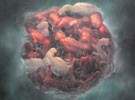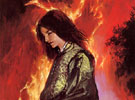
展览时间:2010-11-25 ~ 2011-03-06
展览地点:林冠画廊
策 展 人:杰弗瑞·第伊奇
参展艺术家:罗伯特·劳森伯格、大卫·萨莱、迈克尔·白维拉克
展览介绍:
此次林冠画廊推出的年末大展将由罗伯特·劳森伯格,大卫·萨莱,迈克尔·白维拉克的三幅巨画组成。
展览将带领大家重新体验传统的美国巨画,领略纽约学校和流行时代艺术家的史诗巨作,一览美国社会的形形色色。
展览由三幅色彩绚烂的作品组成:罗伯特•劳森伯格的《10码销售》(TenYardSale,1999,306x884cm),大卫•萨利的《可以贩卖的歌曲》(SongsforSale,1997,305x2621cm)以及迈克尔·白维拉克的《原形毕露》(ShowYourBones,2006,274x1097cm)罗伯特·劳森伯格(1925-2008)艺术生涯起于20世纪50年代,直到他两年前去世,在漫长的83年中,他始终是美国最具影响力的艺术家之一。
劳森伯格作品大都取材于同时期的美国日常生活,他善于发现平凡生活中的优雅美丽,例如曼哈顿屋顶的水槽,摇晃的小屋,电缆卷筒或者一堆废弃的瓦片,都可以成为他创作的素材。无论是组合,丝印还是图片拼接都成了劳森伯格的特殊签名。强烈的视觉可触性和完美的美学平衡让他的作品在同时代中独树一帜。劳森伯格的创作融合了色彩,形式,视觉韵律的美感,因而他的作品具备很强的感官冲击和立体感。
劳森伯格的作品曾作为林冠画廊的开幕展,作为拼组新词(双关语)系列中最大的作品,《10码销售》当然也囊括其中。作家玛丽··恩科茨在《劳森伯格:艺术与生活》一书中写到,拼组新词(双关语)系列讲述了20世纪末劳森伯格在旅途中的感悟。字面上看,他对意象进行重组以发现深藏的信息,他把寻常的,特别的,大众的重新组合成劳森伯格式的表现形式。通过记录他经历的照片,劳森伯格以一个叙述者的姿态将观者融入其中,而他的作品往往也能在观众中产生共鸣。
大卫·萨莱(1952)在20世纪80年代创作的一系列巨幅作品使他成为了享有国际盛誉的绘画大师。他巧妙的把各种意象或者物体的片段进行并列排放,善于引用艺术历史,广告,电影,喜剧甚至是色情作品,并且乐于从他个人的黑白照片中寻找灵感。因而复杂,并置拼接也成了大卫作品的代名词。
用大卫·萨莱自己的话来形容《可以贩卖的歌曲》(1997),这件作品是美国印象丰富的缩影。创作过程中,同名的音乐剧给了大卫灵感,作品如同同时期的流行音乐和舞蹈一般,充满了切分和对位的韵律。流线型的表现方式,壁画般的尺寸,可以贩卖的歌曲就像19世纪的露营歌曲和沙龙歌曲一般,表现了美国本土生活的多元化。
作品表现的是流行和当下。从背后看,作品是美国艺术历史中的经典意象,其中蕴含了障眼法这种表现形式,同时也表现了自我反省,这种相对近现代艺术的态度。作品既可以视为从中心向左右两边发散,又可以看成是首尾相接,不停循环连续。
26米的长度已经让观者震撼,无论是对色彩的掌控,还是图像间技巧的转换都让观者深深迷失在这幅巨作前。这幅作品的神秘在于它能带给观者强烈的感官享受,如同给予饥饿者以饱腹之感,寒冷者以温暖之感,诉说者以聆听之感。
迈克尔·白维拉克(1966)的作品也曾在林冠展出。20世纪90年代早期,迈克尔就以其明朗的色彩,图表式的绘画方式和流行的主题闻名全球。视觉碎片的并列重组,无论是具体的还是抽象的,带有文化标记的还是纯粹个人感受的,都让迈克尔的作品独树一帜。
《原形毕露》(2006)是迈克尔最具代表性的作品。作品的题目很好的阐述了迈克尔的艺术生涯和他对艺术的感悟。作品的架构和当代音乐作品的架构如出一辙,很好的诠释了当代意识流的分层。从《原形毕露》中,可以发现两种自我意识的代替品。从门廊到他先前工作室的图像和酒瓶与喷雾壶的静物写生,这些暗示了他青年时学习绘画的历程。同时我们也不难找到他对前期作品的部分引用以及他画的赛车中的大大的数字7。此外,这件作品也是对迈克尔产生共鸣的音乐专辑,视频等意象的排列。
此次展览由杰弗瑞•第伊奇策划,曾于2006年在他纽约的第伊奇艺术空间展出。我们很荣幸这次能为中国观众带来这样一场具有特殊性的年末大展。让我们拭目以待。
Songs for Sale, is an exhibition of three large-scale paintings by Robert Rauschenberg, David Salle, and Michael Bevilacqua now opening at FAURSCHOU BEIJING.
The exhibition celebrates the tradition of the “big American painting,” the epic works of the New York School and Pop era painters that reflect the scale of the American landscape and the sweep of the American vision.
The exhibition features three ambitious works: Robert Rauschenberg’s Ten Yard Sale, 1999, (306 x 884 cm), David Salle’s Songs for Sale, (1997, 305 x 2621 cm), and Michael Bevilacqua’s Show Your Bones, (2006, 274x 1097 cm). Robert Rauschenberg (1925 – 2008) has had the capacity of being one of the most important American artists ever since the beginning of his career in the 1950’s - right until his death two years ago at the age of 83. Rauschenberg works collects images from American everyday life, where the fine and beautiful equally is to be found in prosaic things such as a Manhattan rooftop water tank, a ramshackle shed, a cable drum, or a stack of old roof tiles. His Combines, silk-screens and photo collages all bear his trademark: The tactile surface and the aesthetic balance of his compositions. He was unsurpassed in colour, composition, visual rhythm; and an aesthetic genius when it came to the sensual surface and materiality of the work.
The inaugural exhibition at FAURSCHOU BEIJING was a three decades show of works by Robert Rauschenberg where Ten Yard Sale was included. It is one of the largest works from the Anagrams (A Pun) series. Mary Lynn Kotz, author of “Rauschenberg/Art and Life”, describes the Anagrams as telling “his story of the world in the last few years of the twentieth century through imagery collected from his travels. As in verbal anagrams, he rearranged his images to ‘discover a hidden message,’ one that brings the ordinary, the unique, and the universal into his own collaged-image patterns. As always, though the photographs record his experience, Rauschenberg left it up to the viewer to supply the narrative, to make a personal connection among the images the artist brought to paper.”
David Salle (1952) had his international breakthrough as a painter in the 1980’s with his large figurative works, eclectically juxtaposing various image fragments and objects. Quoting art history, advertising, films, erotica, comics and his own black and white photographs, Salle creates complex, collage-like compositions.
David Salle describes Songs for Sale (1997) as “a cornucopia of American images.” In developing the composition, the artist was inspired by the American musical theatre, which is reflected in the title. The composition is analogous to popular music and dance; it is full of syncopated and contrapuntal rhythms. “It’s like a big piece of sheet music,” Salle says of this piece which has the size of a mural. “Like a 19th Century camping song or saloon song, grabbing disparate elements of the American Vernacular.”
The imagery is Pop and contemporary. The central image of the mural is that of painting itself – a canvas stretcher turned away from the viewer. The painting seen from behind is a classic image from American art history referring both to the trompe l’oeil tradition and to the self-reflexive attitude of much recent art. The composition flows out in both directions from this centre point of the reversed canvas. It is as if both ends of the painting could be brought together to form a continuous band, a great encircling loop.
The sheer size of the painting makes it amazing – the painting is 26 meter long, the myriad of images and the numerous shifts in scale keep the eye pulsing across the picture surface. The painting offers sensual pleasures as well; it overflows with images of things to eat and drink, to touch, and hear.
Michael Bevilacqua (1966) has previously shown at Faurschou Beijing. He started out in the early 1990’s, when he became known for his Pop-inspired, brightly coloured, graphic paintings. They have a collage-like quality and are composed from a mass of visual fragments – both figurative and abstract; cultural icon and personal reference.
Show Your Bones (2006) is Michael Bevilacqua’s largest and most ambitious painting. Its title refers to the way the imagery of the painting sums up the artist’s influences and his own history as an artist. The structure of the work corresponds to the structure of sampling and layering in contemporary musical composition. It also reflects the spliced and layered structure of contemporary consciousness. Bevilacqua’s composition includes two surrogate self portraits, the doorway to his former studio, and a still life of wine bottles and spray cans, an allusion to the way he learned to paint as a teenager. There are also quotations from some of his earlier paintings and the big number 7 from the side of his painted racecar. There is also an array of images from album covers and music videos that intersect with his artistic interests.
This show was originally made in 2006 by Jeffrey Deitch and was shown in his New York Space, Deitch Projects. We are pleased to show these remarkable paintings for a Chinese audience.
SONGS FOR SALE
ROBERT RAUSCHENBERG
DAVID SALLE
MICHAEL BEVILACQUA
NOVember 25 2010 – MARCH 6 2011
Curated by Jeffrey Deitch
- 2011-04-30 ~ 2011-05-30出窍记·缪晓春个展
- 2011-04-29 ~ 2011-05-20静中人Figures of Silence —Michel Madore
- 2011-04-30 ~ 2011-05-14黑白
- 2011-05-28 ~ 2011-07-28四重奏——孟昌明水墨荷花作品展
- 2011-05-28 ~ 2011-06-24“远与近”意大利当代著名艺术家作品展
- 2011-05-28 ~ 2011-07-02底下有石头:杨心广个展
- 2011-05-21 ~ 2011-06-20湖滨诗境──Celest生态摄影展(续展)
- 2011-05-21 ~ 2011-06-05缓行——十二位八零后艺术家
- 2011-04-28 ~ 2011-06-05观天悟道——张国龙艺术巡展
- 2011-05-28 ~ 2011-07-10诺特·维塔尔:激浸




